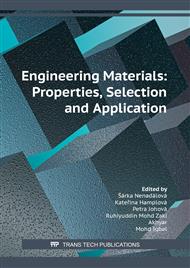[1]
I.P.A. Shidiq, M.H. Ismail, M.F. Ramli, N. Kamarudin, Combination of alos palsar and landsat 5 imagery for rubber tree mapping, Malaysian For. 80 (2017) 55 –72.
Google Scholar
[2]
Widyarani, S.C.W. Coulen, J.P.M. Sanders, M.E. Bruins, Valorisation of proteins from rubber tree, Waste and Biomass Valorization. 8 (2017) 1027–1041.
DOI: 10.1007/s12649-016-9688-9
Google Scholar
[3]
H.S. Sik, Z. Zahidah, S.S. How, I. A. Ramzul, Recovery of sawn timber from accelerated kiln drying, Int. J. Agric. For. Plant. 10 (2020) 287–291.
Google Scholar
[4]
P. S. Khoo, Physical properties and bonding quality of laminated veneer lumber produced with veneers peeled from small-diameter rubberwood, R. Soc. Open Sci. (2019) 6191763.
DOI: 10.1098/rsos.191763
Google Scholar
[5]
J. Balfas, Impregnation of teak extract and resins in rubberwood and fast-grown teak wood, J. Trop. For. Sci. 31 (2019) 189–199.
DOI: 10.26525/jtfs2019.31.2.189199
Google Scholar
[6]
L.F. Douglas, Performance of glulam beams produced with free-formaldehyde adhesive and underexploited rubber wood treated with preservatives solutions of chromated copper borate and pyrethroids show less pages, J. Adhes. Sci. Technol, 34 (2020) 1145–1162.
DOI: 10.1080/01694243.2019.1700075
Google Scholar
[7]
M. Faris T.H. Mohammed, A hierarchy weighting preferences model to optimise green composite characteristics for better sustainable bio-products, Int. J. Sustain. Eng. (2020) 1–6.
Google Scholar
[8]
N. Sharina, Effects of core grain orientation on the mechanical properties of wood sandwich composite, J. Trop. Resour. Sustain. Sci. 6 (2018) 27–30.
Google Scholar
[9]
S. Jiang, F. Sun, X. Zhang, H. Fan, Interlocking orthogrid: an efficient way to construct lightweight lattice-core sandwich composite structure, Compos. Struct. 176 (2017) 55–71.
DOI: 10.1016/j.compstruct.2017.05.029
Google Scholar
[10]
J. Smardzewski, Experimental and numerical analysis of wooden sandwich panels with an auxetic core and oval cells, Mater. Des. 183 (2019) 108–159.
DOI: 10.1016/j.matdes.2019.108159
Google Scholar
[11]
Y. Fu, P. Sadeghian, Flexural and shear characteristics of bio-based sandwich beams made of hollow and foam-filled paper honeycomb cores and flax fiber composite skins, Thin-Walled Struct. 153 (2020) 106834.
DOI: 10.1016/j.tws.2020.106834
Google Scholar
[12]
H. Shi, F. Hai, W. Liu, and Z. Xia, Flexural fatigue behavior and life prediction of web reinforced gfrp-balsa sandwich beams, Int. J. Fatigue, 136 (2020) 105592.
DOI: 10.1016/j.ijfatigue.2020.105592
Google Scholar
[13]
J. P. Vitale, G. Francucci, J. Xiong, A. Stocchi, Failure mode maps of natural and synthetic fiber reinforced composite sandwich panels, Compos. Part A Appl. Sci. Manuf. 94 (2017) 217–225.
DOI: 10.1016/j.compositesa.2016.12.021
Google Scholar
[14]
A. Dogan, Low-velocity impact, bending, compression response of carbon fiber/epoxy-based sandwich composites with different types of core materials, J. Sandw. Struct. Mater. (2020) 1–16.
DOI: 10.1177/1099636220908862
Google Scholar
[15]
R. Laulkar, M. Gaikwad, A. Mohan, M. Joshi, Flexural behavior of sandwich structures with rohacell 71-hero foam and ox-honeycomb cores, Mater. Today Proc. 21 (2020) 1116–1122.
DOI: 10.1016/j.matpr.2020.01.059
Google Scholar
[16]
M.K. Khan, T. Baig, S. Mirza, Experimental investigation of in-plane and out-of-plane crushing of aluminum honeycomb, Mater. Sci. Eng. A, 539 (2012) 135–142.
DOI: 10.1016/j.msea.2012.01.070
Google Scholar
[17]
M.R. Sanjay, P. Madhu, M. Jawaid, P. Senthamaraikannan, S. Senthil, S. Pradeep, Characterization and properties of natural fiber polymer composites: a comprehensive review, J. Clean. Prod. 172 (2018) 566–581.
DOI: 10.1016/j.jclepro.2017.10.101
Google Scholar
[18]
L. Guillaumat, S. Terekhina, I. Derbali, A. Monti, A. El Mahi, Z. Jendli, Flax fibers reinforced thermoplastic resin based biocomposites, a future for sustainable composite parts, in MATEC Web of Conferences. 203 (2018) 1–11.
DOI: 10.1051/matecconf/201820306019
Google Scholar
[19]
O. Ozdemir, N. Oztoprak, H. Kandas, Single and repeated impact behaviors of bio-sandwich structures consisting of thermoplastic face sheets and different balsa core thicknesses, Compos. Part B Eng. 149 (2018) 49–57.
DOI: 10.1016/j.compositesb.2018.05.016
Google Scholar
[20]
E. Sarikaya, H. Çallioğlu, H. Demirel, Production of epoxy composites reinforced by different natural fibers and their mechanical properties, Compos. Part B Eng. 167 (2019) 461–466.
DOI: 10.1016/j.compositesb.2019.03.020
Google Scholar
[21]
J. Hao, X. Wu, G. Oporto, W. Liu, J. Wang, Structural analysis and strength to weight optimization of wood based sandwich composite with honeycomb core under three point flexural test, Eur. J. Wood Prod. 78 (2020) 1195–1207.
DOI: 10.1007/s00107-020-01574-1
Google Scholar
[22]
G. Neje, B.K. Behera, Influence of cell geometrical parameters on the mechanical properties of 3d integrally woven spacer sandwich composites, Compos. Part B Eng. 182 (2020) 107659.
DOI: 10.1016/j.compositesb.2019.107659
Google Scholar
[23]
J. Zhang, G. Lu, Z. You, Large deformation and energy absorption of additively manufactured auxetic materials and structures: a review, Compos. Part B, 201 (2020) 108340.
DOI: 10.1016/j.compositesb.2020.108340
Google Scholar
[24]
M. Osei-Antwi, J. De Castro, A. P. Vassilopoulos, T. Keller, Shear mechanical characterization of balsa wood as core material of composite sandwich panels, Constr. Build. Mater. 41 (2013) 231– 238.
DOI: 10.1016/j.conbuildmat.2012.11.009
Google Scholar
[25]
M. Borrega, P. Ahvenainen, R. Serimaa, L. Gibson, Composition and structure of balsa (ochroma pyramidale) wood, Wood Sci. Technol. 49 (2015) 403–420.
DOI: 10.1007/s00226-015-0700-5
Google Scholar
[26]
M. Sadighi, A.A. Dehkordi, R. Khodambashi, A theoretical and experimental study of failure maps of sandwich beams with composite skins and honeycomb core, Int. J. Model. Identification, Simul. Control, 42 (2010) 37–47.
Google Scholar
[27]
Z. Wang, Z. Li, W. Xiong, Numerical study on three-point bending behavior of honeycomb sandwich with ceramic tile, Compos. Part B Eng. 167 (2019) 63–70.
DOI: 10.1016/j.compositesb.2018.11.108
Google Scholar
[28]
I. Ivañez, L.M. Fernandez-Cañadas, S. Sanchez-Saez, Compressive deformation and energy- absorption capability of aluminium honeycomb core, Compos. Struct. 174 (2017) 123–133.
DOI: 10.1016/j.compstruct.2017.04.056
Google Scholar
[29]
K.M.P. Surya, I. Balasundar, K. Gopinath, T. Raghu, Parametric study on factors influencing the stiffness of honeycomb sandwich panels using impulse excitation technique, J. Sandw. Struct. Mater. 21 (2019) 115–134.
DOI: 10.1177/1099636216686649
Google Scholar
[30]
S.K. Sahu, N.D. Badgayan, S. Samanta, D. Sahu, P.S.R. Sreekanth, Influence of cell size on out of plane stiffness and in-plane compliance character of the sandwich beam made with tunable PCTPE nylon honeycomb core and hybrid polymer nanocomposite skin, Int. J. Mech. Sci. 148 (2018) 284–292.
DOI: 10.1016/j.ijmecsci.2018.08.011
Google Scholar
[31]
H.S. Lee, S.H. Hong, J.R. Lee, Y.K. Kim, Mechanical behavior and failure process during compressive and shear deformation of honeycomb composite at elevated temperatures, J. Mater. Sci., 37 (2002) 1265–1272.
Google Scholar
[32]
N. Mitra, A Methodology for improving shear performance of marine grade sandwich composites: sandwich composite panel with shear key, Compos. Struct. 92 (2010) 1065–1072.
DOI: 10.1016/j.compstruct.2009.10.005
Google Scholar
[33]
G. Ye, Compression properties of two-dimensional wood-based dowel lattice structure filled with polyurethane foam, BioResources, 14 (2019) 8849–8865.
Google Scholar
[34]
A.Y. Chen, D.F. Li, J.B. Zhang, F. Liu, X.R. Liu, J. Lu, Study of toughening mechanisms through the observations of crack propagation in nanostructured and layered metallic sheet, Mater. Sci. Eng. A, 528 (2011) 8389–8395.
DOI: 10.1016/j.msea.2011.07.063
Google Scholar
[35]
L. Cai, D. Zhang, S. Zhou, W. Xu, Investigation on mechanical properties and equivalent model of aluminum honeycomb sandwich panels, J. Mater. Eng. Perform. 27 (2018) 6585–6596.
DOI: 10.1007/s11665-018-3771-2
Google Scholar
[36]
C. Chen, Y. Li, Y. Gu, M. Li, Z. Zhang, Improvement in Skin – Core adhesion of multiwalled carbon nanotubes modified carbon fiber prepreg / nomex honeycomb sandwich composites, J. Reinf. Plast. Compos. 36 (2017) 608–618.
DOI: 10.1177/0731684416687042
Google Scholar



